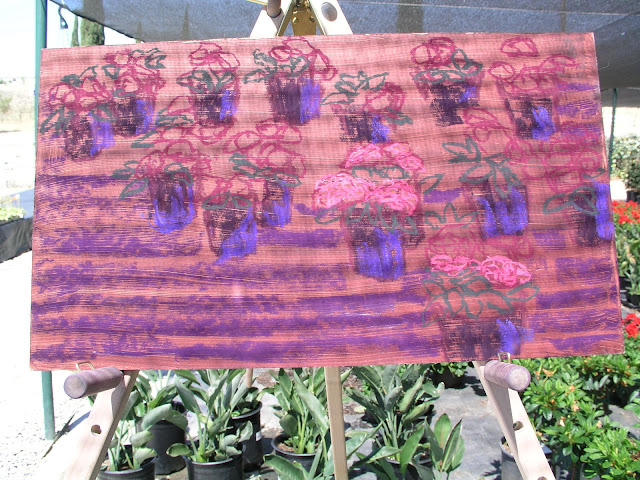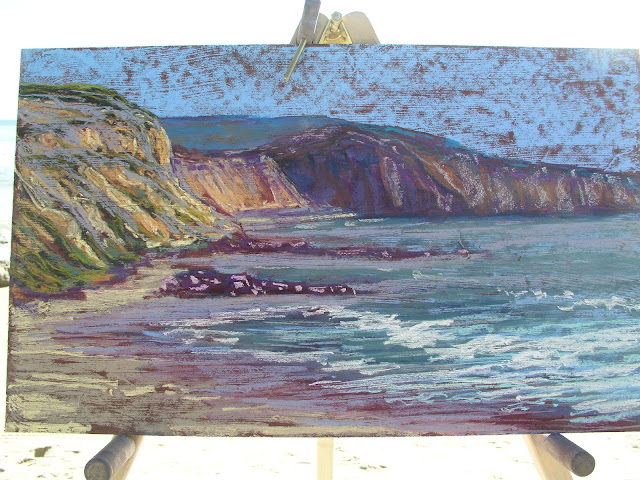Sunday, April 21, 2013
Monday, April 15, 2013
Painting At The End Of The Street
Painting At The End Of The Street
 |
In addition to developing the shapes, colors, and values in the foreground; I also attempted to create the feeling of distance and grab the shapes of the clouds before they changed.
|
Painting At The End Of The Street
 |
If I had done a better job at getting the shapes of the hills more accurate it would have made it easier to get to the relationship between them in the distance.
|
This is one of those paintings that I would have liked to have a couple of more hours of painting. I liked the colors and detail level of the hills in the distance but would have liked to develop the foreground more and built a better separation between the foreground and the middle ground.
Painting in Black Star Canyon
I was supposed to meet a group of people to paint in Black Star Canyon. I couldn't find the group. I wasn't sure if I looked in the wrong spot or the event was canceled. After driving around trying to find it I decided to just stop and start painting. The day was overcast and I was not sure if the sun was going to come out at all. The red rocks presented a challenge because the color of them would be hard to put into atmospheric perspective.
I had prepared four boards to paint on that morning. I picked this blue gray color because I thought it was what the lighting that day was going to be. It turned out to be a good choice. This board is about 24"X36". After doing a sketch I got a good feel for the composition. As it turned out I did not get everything in the painting I wanted to but I did not want to sacrifice the shape of the rocks in the background.
I started with the background in this painting because I thought it was the most important part of the painting to get right. It had the most challenges. Some of the problems I had to solve were; the light changing on the face of the rocks, making sure that the rocks were not too bright or red so that they would stay in the back ground, getting the detail in the rocks and the trees without detracting from the middle and foreground.
I had prepared four boards to paint on that morning. I picked this blue gray color because I thought it was what the lighting that day was going to be. It turned out to be a good choice. This board is about 24"X36". After doing a sketch I got a good feel for the composition. As it turned out I did not get everything in the painting I wanted to but I did not want to sacrifice the shape of the rocks in the background.
I started with the background in this painting because I thought it was the most important part of the painting to get right. It had the most challenges. Some of the problems I had to solve were; the light changing on the face of the rocks, making sure that the rocks were not too bright or red so that they would stay in the back ground, getting the detail in the rocks and the trees without detracting from the middle and foreground.
Painting in Black Star Canyon
The sage in the foreground was naturally gray anyway so the lighting made it easier to make it warmer. I felt like I really nailed the variation of values and maintained the light key in the middle and foreground.
Black Star Canyon Finished
Tuesday, April 9, 2013
Hydrangeas
Hydrangeas Under the Shadecloth
 |
One of the continuing challenges with painting smaller is the resolution of the subjects within the composition. The impressionistic strokes seem to make the painting less substantive.
|
Painting in the Nursery
 |
The end result is not typical of my paintings. There is a lot less detail.
|
Sunday, April 7, 2013
Second Painting of the Day
 |
I took a different approach in this painting. There was less drawing and more painting and layering of colors in this painting.
|
My underpainting was close to the complementary color of the masonite I was painting on. It helped create the feeling of vibration in the painting.
Transformation of the Painting
 |
I picked up a cool red / purple to create a different feeling in the shadows and the details of the painting. It was intended to help create the feeling of atmospheric perspective.
|
 |
At this point in the painting I felt like I had to create a feeling of separation between the bluffs in the foreground, the middle ground, and the background.
|
To create a better feeling of distance I lightened the cliffs in the distance. Reducing the saturation of the cliffs helped the reading of the entire painting although I did like the colors better before I scrumbled the light violet pastel over them.
Done for the Day
 |
This painting is much simpler than my first painting of the day. Because of the size of the painting and the speed with which I paint I had to be careful to not overwork that painting.
|
Wednesday, April 3, 2013
Pelican Point
 |
Painting at low tide in Crystal Cove at Pelican Point. The clouds had burned off just as I got to the beach. I carried down my 40 pounds of gear and took a bunch of reference photographs.
|
 |
I set up in a location that had at least two distinct subjects that I wanted to paint.
|
I did my preliminary sketch to make sure my composition was going to work.
Building My Painting of Pelican Point
The detail only continues as I try to fill the space with everything that I see around me. There is no going back now just going forward.
I put in some of the highlights and put in the shadows. The texture of the bluff and the contours of the sandstone had to be maintained. Instead of blending I had to continue drawing in the detail.
Painting at Pelican Point
 |
As all the thoughts about what I wanted to do with the painting I never stopped painting. I just kept trying to figure out how to solve the problems my painting presented until I got to the point where I knew I was done.
Subscribe to:
Comments (Atom)







































